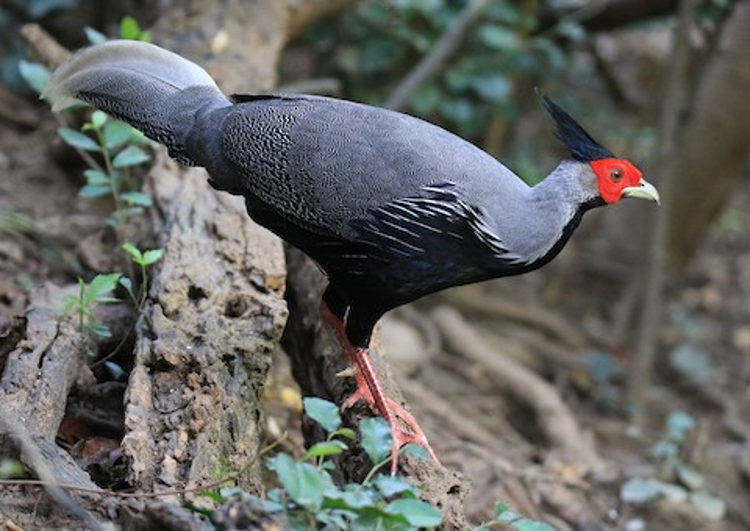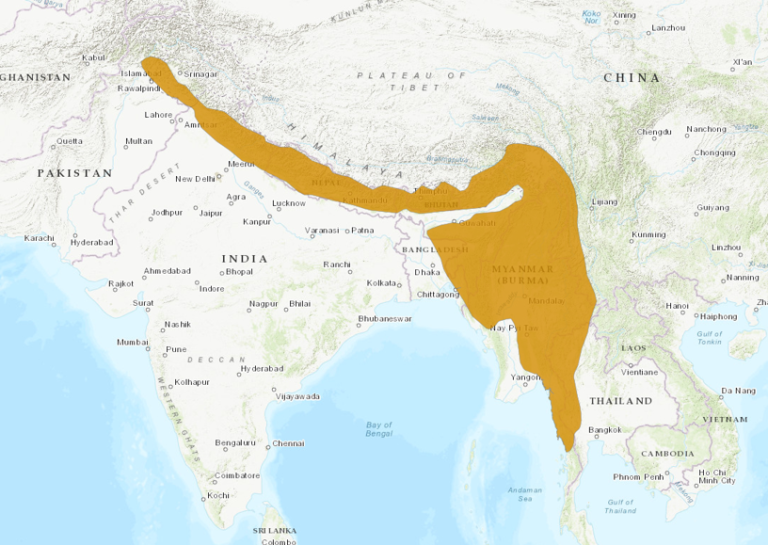Birdfinding.info ⇒ This extremely variable species is locally common in several parts of its range, but most readily observed in a few areas, especially in Uttarakhand at Sattal, Nainital, and Corbett National Park. Other sites where it can usually be found include the Godawari Forest in Nepal; the mountains of West Bengal (Mahananda Wildlife Sanctuary and Singalila and Neora Valley National Parks); Chelela in Bhutan; Manas and Kaziranga National Parks in Assam; the Hongbenghe area of western Yunnan; and in western Thailand at Mae Wong and Kaeng Krachan National Parks. It has been introduced and is now well established on Hawaii’s Big Island, where it can be found most readily in Hawaii Volcanoes National Park, on southeastern slopes of Mauna Kea, and in the hills north of Kailua-Kona. On Oahu, a small population appears to be established in the western hills, including Nanakuli Forest Reserve.
Kalij Pheasant
Lophura leucomelanos
Tropical and subtropical forests of Southern Asia, from foothills up to at least 11,000’ elevation.
The Kalij Pheasant is taxonomically complex, consisting of several races (nine recognized subspecies) that differ widely in appearance but interbreed freely in areas of occasional overlap between them. Adding to the complexity, its sibling species, the Silver Pheasant, shows a similar degree of variation, and the races of Kalij and Silver that occupy adjacent areas sometimes interbreed and resemble one another more than either of them resembles distant races of their own species. The current classification of these intermediate races, along with the division of all Kalij-Silver races into two species, is based on genetic analyses of relatedness that strongly indicate both the validity of the distinction and the location of the line between them.
The Kalij Pheasant occupies two adjoining regions: (1) the southern slopes and valleys of the Himalayas from northern Pakistan east to northern Myanmar and southern China; and (2) most of Myanmar plus adjacent areas of India, Bangladesh, China, and Thailand.
An introduced population of the western race is well established on Hawaii’s Big Island and more tenuously on Oahu.
Identification
A highly variable pheasant with bright-red facial skin and broad fanlike tail feathers. Male is large (about 80 cm long, including 30 cm tail) and robust (up to 1 kg). Female is about three-quarters of the length and less than half the bulk of the male.
Males vary so widely that they defy most generalizations, except that their plumage is a mix of black and white—usually with a blue gloss apparent on some of the black feathers—and their tail feathers are broad and proportionately short (relative to other pheasants).
There are three main forms, with numerous variations and gradations, that can be simplified approximately as: (1) “Typical” from Pakistan to Nepal, and introduced to Hawaii; (2) “Black” from eastern Nepal to Myanmar and southern China; and (3) “Silver” in southern Myanmar and western Thailand. Some populations show significant internal variation as well.
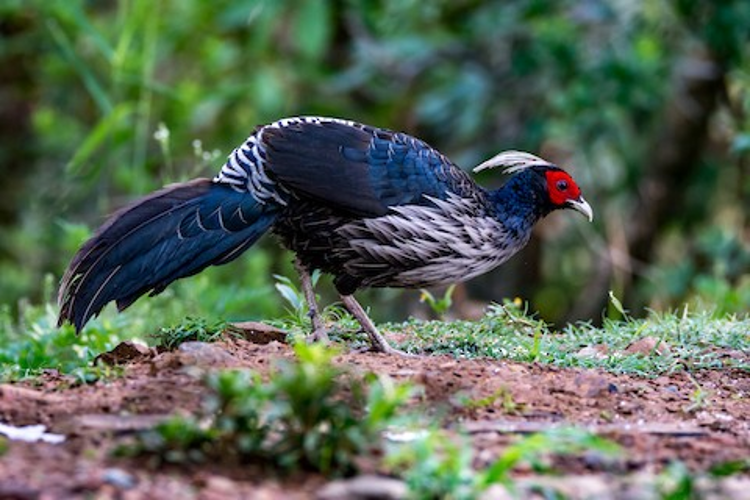
Kalij Pheasant, L. l. hamiltonii or leucomelanos, male. (Bhimtal, Nainital, Uttarakhand, India; June 7, 2017.) © Susanta Basak
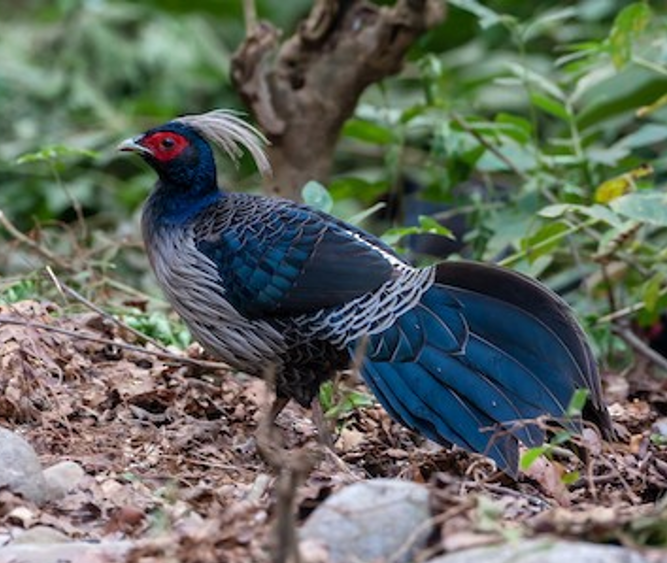
Kalij Pheasant, L. l. hamiltonii or leucomelanos, male. (Corbett National Park, Uttarakhand, India; November 22, 2010.) © Gyorgy Szimuly
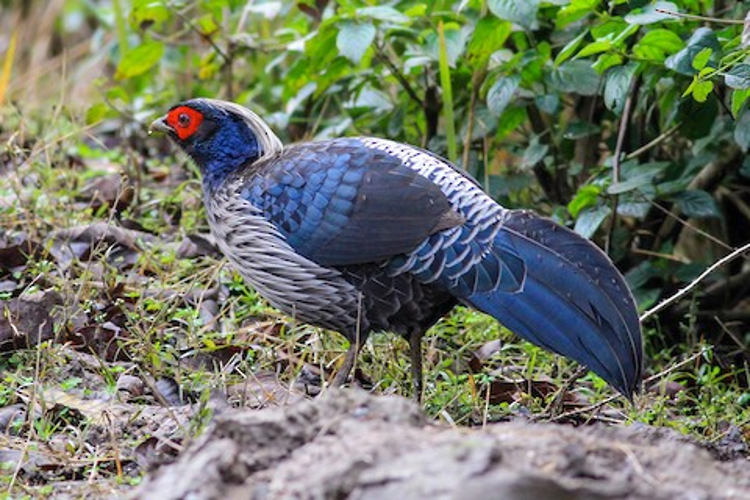
Kalij Pheasant, L. l. hamiltonii or leucomelanos, male showing more extensive white on the back than most. (Corbett National Park, Uttarakhand, India; February 3, 2015.) © Stefan Hirsch
“Typical” males are black with a bluish gloss on the neck, back, wing coverts, and tail, and variable amounts of elongated white or gray feathers on the throat and breast, variable white scaling on the back and rump, and a white or gray topknot.

Kalij Pheasant, L. l. hamiltonii or leucomelanos, male. (Sattal, Nainital, Uttarakhand, India; March 31, 2018.) © Cláudia Brasileiro

Kalij Pheasant, L. l. hamiltonii or leucomelanos, male showing typical coloration. (Sattal, Nainital, Uttarakhand, India; November 9, 2019.) © Venkatesh V.T.
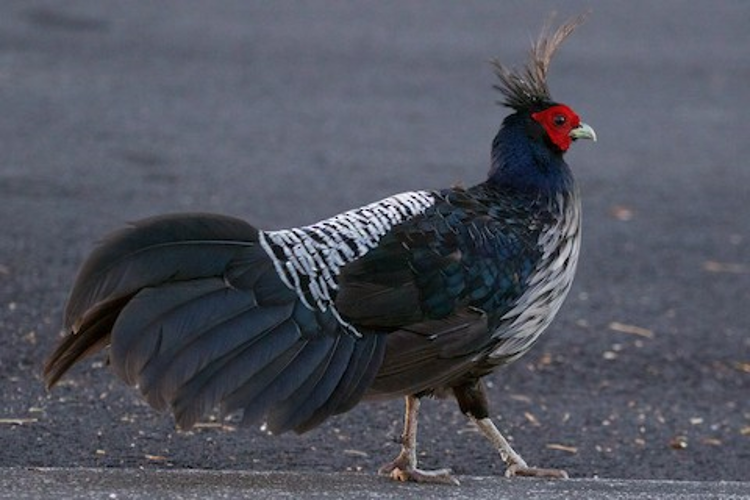
Kalij Pheasant, L. l. hamiltonii or leucomelanos, male in display posture. (Kona Heights, Big Island, Hawaii; January 1, 2019.) © Reginald David
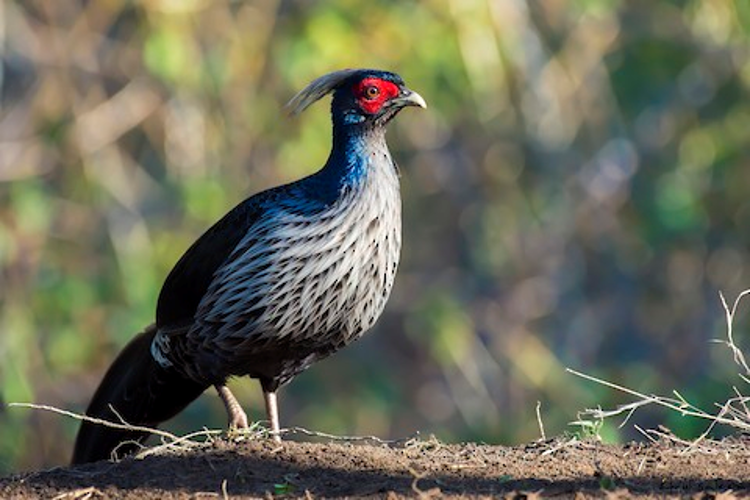
Kalij Pheasant, L. l. hamiltonii or leucomelanos, male showing elongated white feathers on underparts. (Nainital, Uttarakhand, India; March 6, 2019.) © Abdul Saleem
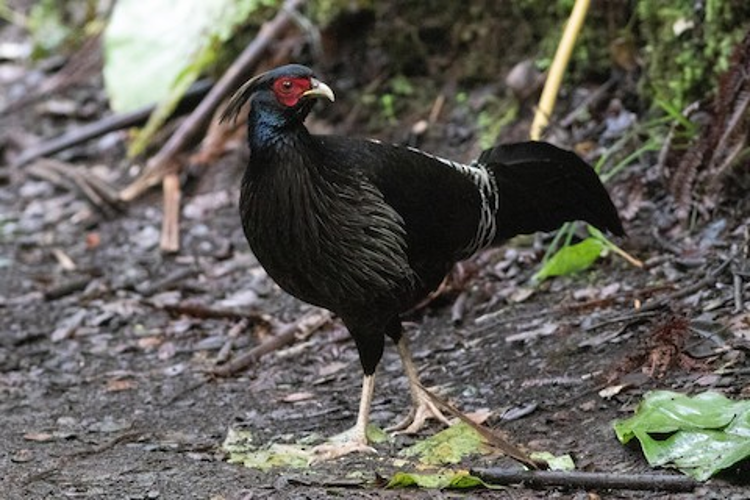
Kalij Pheasant, L. l. hamiltonii or leucomelanos, male with mostly black plumage and dark gray streaks on underparts. (Halema’uma’u Trail, Hawaii Volcanoes National Park, Big Island, Hawaii; December 30, 2019.) © Lucas Bobay

Kalij Pheasant, L. l. hamiltonii or leucomelanos, male showing a vivid blue gloss on black feathers. (Sattal, Nainital, Uttarakhand, India; March 21, 2019.) © Arunava Bhattacharjee

Kalij Pheasant, L. l. hamiltonii or leucomelanos, male with grayish-white streaking on underparts. (Kafal House, Nainital, Uttarakhand, India; April 20, 2019.) © Ramesh Shenai
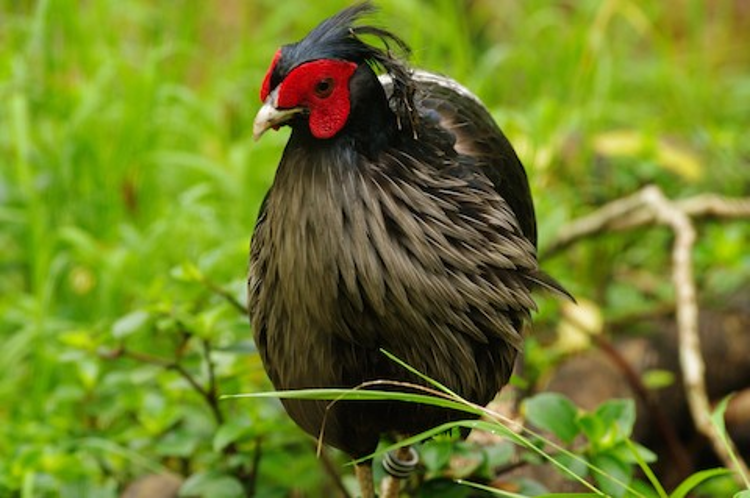
Kalij Pheasant, L. l. hamiltonii or leucomelanos, male with gray streaks on underparts, showing structure of red wattles on face. (Kipuka Puaulu, Hawaii Volcanoes National Park, Big Island, Hawaii; March 6, 2011.) © Brenda Wright

Kalij Pheasant, L. l. hamiltonii or leucomelanos, male showing black upperparts with white scaling on lower back and rump. (Volcano House, Hawaii Volcanoes National Park, Big Island, Hawaii; April 23, 2019.) © Tresa Moulton

Kalij Pheasant, L. l. hamiltonii or leucomelanos, male with largely jet-black coloration, lacking bluish gloss, possibly due to the angle of the light. (Big Island Country Club, Pu’u Anahulu, Big Island, Hawaii; August 5, 2005.) © Michael Walther
“Black” males (mainly from eastern Nepal to Myanmar and southern China) have almost entirely black plumage, including the topknot, often with a bluish gloss, and with varying amounts of white or gray streaking on the neck and white scaling on the back and rump, and sometimes white or gray in the tail.
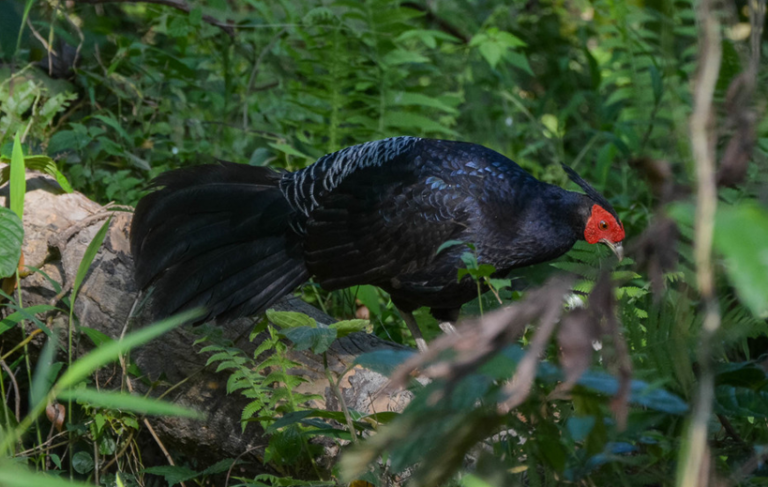
Kalij Pheasant, L. l. lathami, male with nearly all-black plumage. (Baksa, Assam, India; March 21, 2014.) © March Faucher
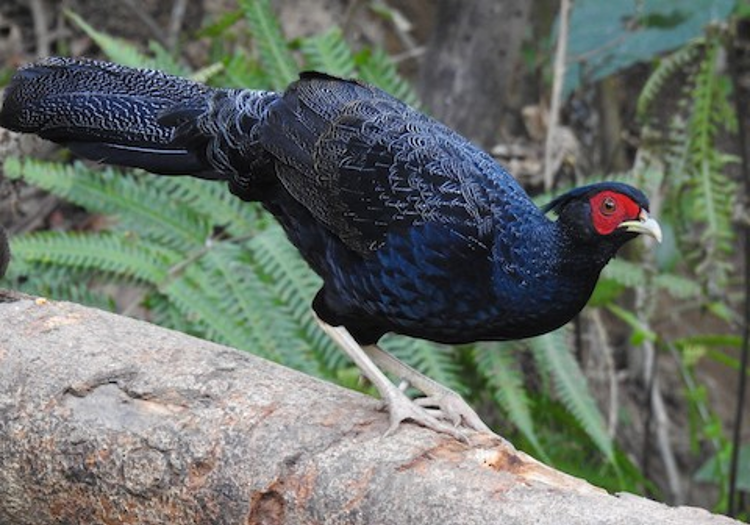
Kalij Pheasant, L. l. lathami, male with nearly all-black plumage but fine white edgings on upperparts. (Tongbiguan, Yunnan, China; January 24, 2019.) © Yuren Cao
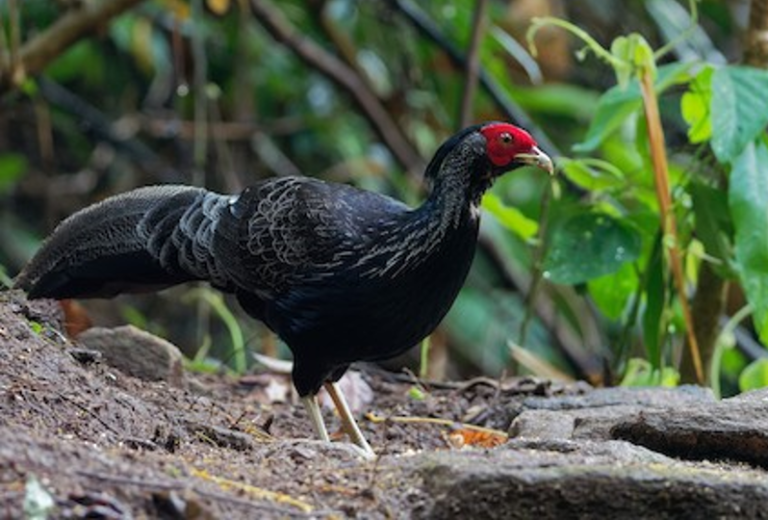
Kalij Pheasant, L. l. lathami, male with mostly black plumage but extensive white edgings on upperparts and partly gray tail. (Shiti Village, Yunnan, China; May 7, 2017.) © Vincent Wang
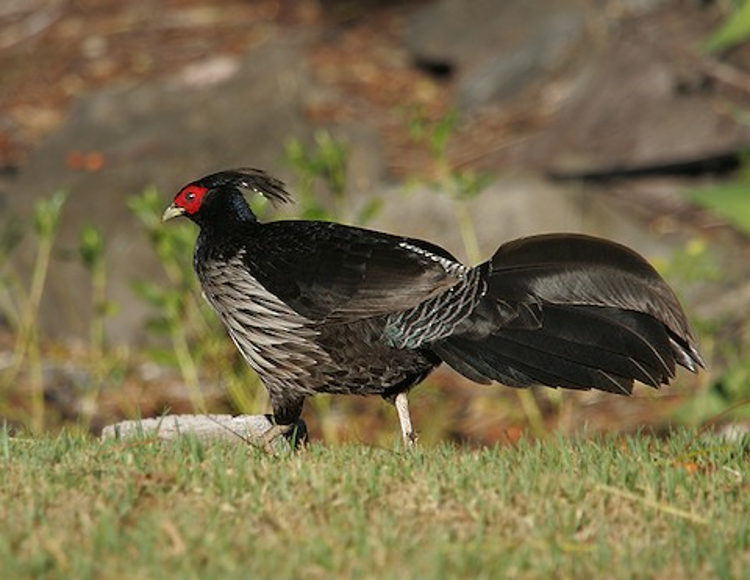
Kalij Pheasant, L. l. hamiltonii or leucomelanos, male of one of the “typical” western subspecies, but with largely jet-black coloration, lacking bluish gloss, possibly due to the angle of the light. (Big Island Country Club, Pu’u Anahulu, Big Island, Hawaii; August 5, 2005.) © Michael Walther

Kalij Pheasant, L. l. lathami, male with nearly all-black plumage but white scaling on lower back and rump. (Pakke Tiger Reserve, East Kameng, Arunachal Pradesh, India; January 3, 2018.) © Snehasis Sinha
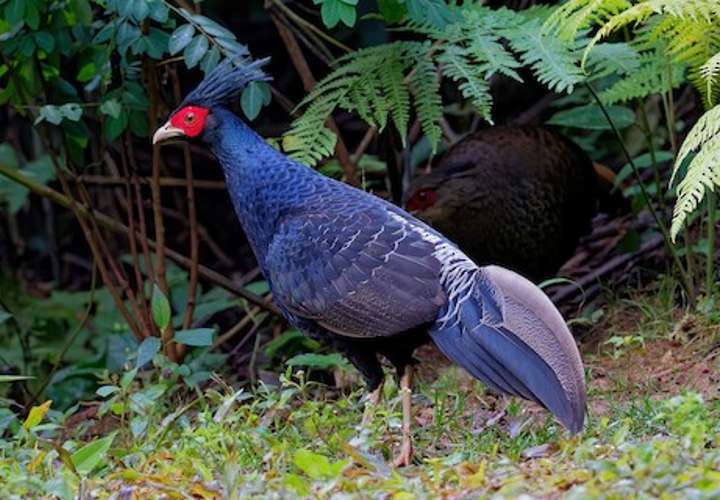
Kalij Pheasant, L. l. lathami, male with mostly black, blue-glossed, plumage but extensive white edgings on upperparts and partly gray tail. (Hongbenghe, Yunnan, China; January 6, 2018.) © Vincent Wang

Kalij Pheasant, L. l. crawfurdii, male of a “Silver” race, showing black-and-white vermiculated upperparts, black crest, largely whitish tail, and pale-gray legs. (Kaeng Krachan National Park, Phetchaburi, Thailand; December 13, 2019.) © David Diller
“Silver” males (mainly eastern Myanmar and western Thailand) have jet-black underparts, mostly white or pale gray upperparts and tail that are variably covered with fine black vermiculations, and a black topknot.
They closely resemble some races of Silver Pheasant, and were formerly classified as races of that species—but have been reclassified based primarily on genetic studies. Some individuals have pink legs, as in Silver Pheasants, while others have the pale-gray legs typical of most Kalij Pheasants.

Kalij Pheasant, L. l. crawfurdii, male of a “Silver” race, showing black-and-white vermiculated upperparts, black crest, largely whitish tail, and pink legs. (Kaeng Krachan National Park, Phetchaburi, Thailand; March 9, 2019.) © Tim Avery
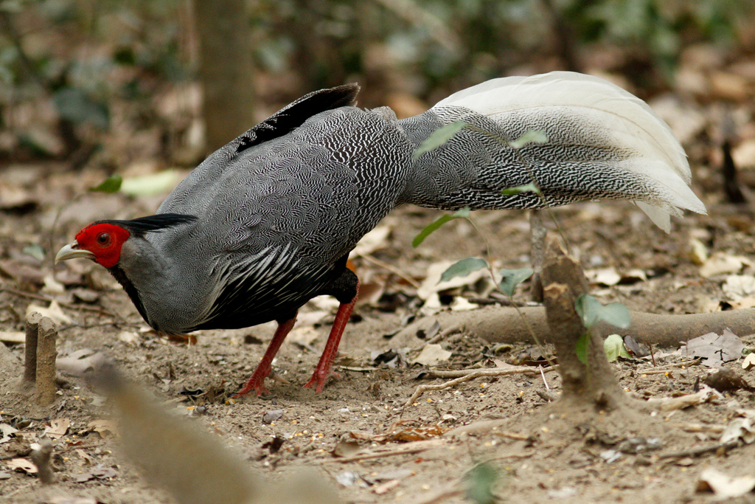
Kalij Pheasant, L. l. crawfurdii, male of a “Silver” race, showing black-and-white vermiculated upperparts, black crest, and largely whitish tail. (Kaeng Krachan National Park, Phetchaburi, Thailand; February 28, 2016.) © Julien Renoult

Kalij Pheasant, L. l. lathami, male showing the same basic pattern as “Silver” males, with mostly black, blue-glossed, plumage but extensive white edgings on upperparts and partly gray tail. (Hongbenghe, Yunnan, China; February 2, 2018.) © Liao Tzu-Chang
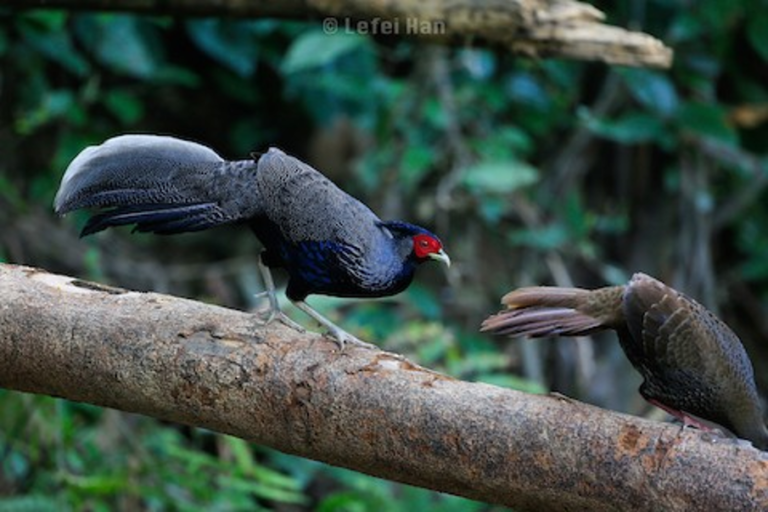
Kalij Pheasant, L. l. lathami—some males of the “Black” subspecies, such as this one, share the same basic pattern as “Silver” males. (Hongbenghe, Yunnan, China; February 8, 2019.) © Lefei Han
Females are also highly variable, but somewhat less so than the males.
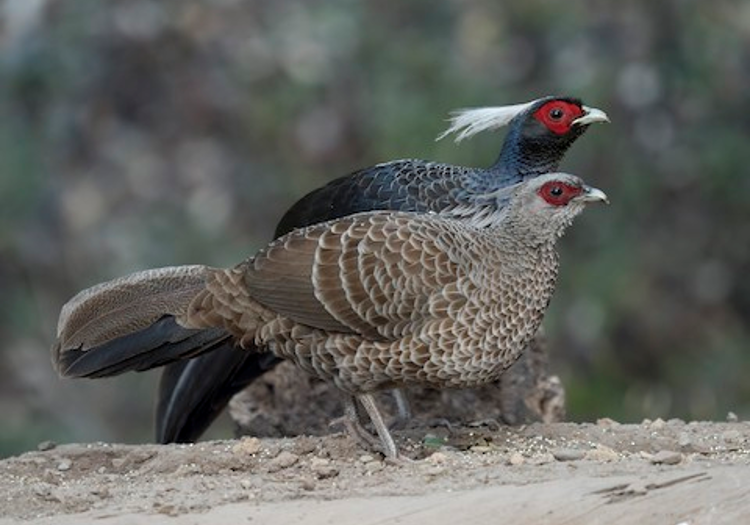
Kalij Pheasant, L. l. hamiltonii or leucomelanos, male and female with mostly cold grayish-brown coloration. (Sattal, Nainital, Uttarakhand, India; March 20, 2019.) © Manolo Arribas
Females of the “Typical” and “Black” races are brown with tan scaling over much of the body. The predominant tone of the brown coloration varies over a wide spectrum, from blackish to whitish at the extremes.
On any given individual, the brown is usually a paler, and often grayer, shade on the head, neck, chest, and back; and it becomes progressively darker toward the tail, and blackest on the outer tail feathers, which often have a blue gloss.
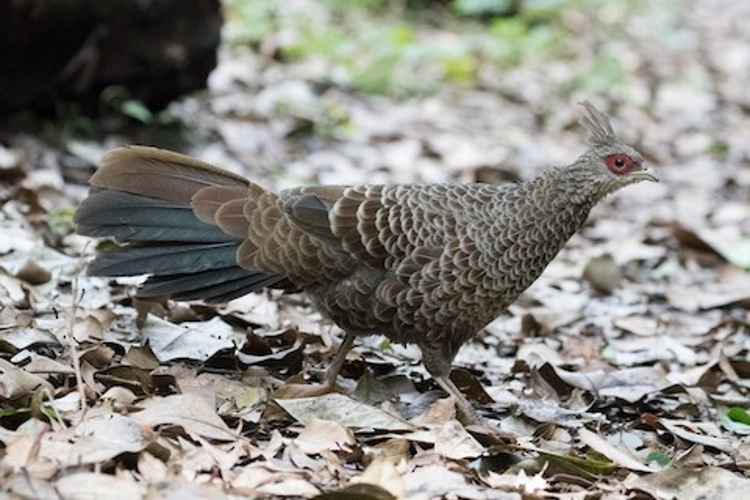
Kalij Pheasant, L. l. hamiltonii or leucomelanos, female with mostly dark-brown coloration, showing black outer tail feathers. (Kipuka Puaulu, Hawaii Volcanoes National Park, Big Island, Hawaii; October 27, 2018.) © Garrett Lau
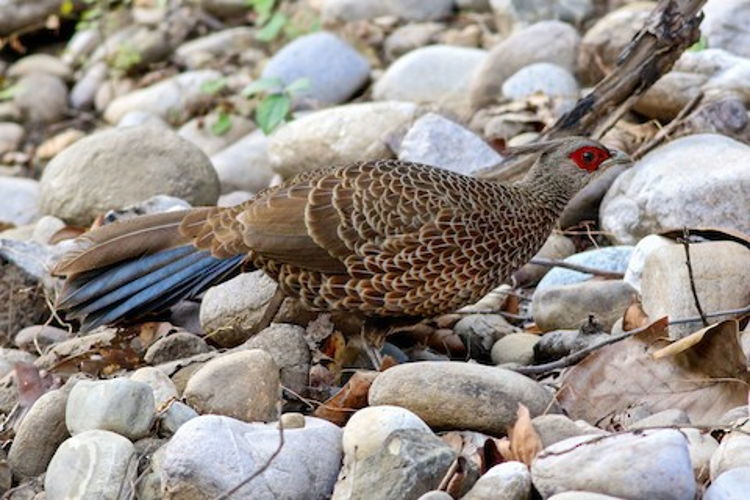
Kalij Pheasant, L. l. hamiltonii or leucomelanos, female with mostly medium-brown coloration, showing black outer tail feathers with bluish gloss. (Corbett National Park, Uttarakhand, India; February 1, 2015.) © Stefan Hirsch
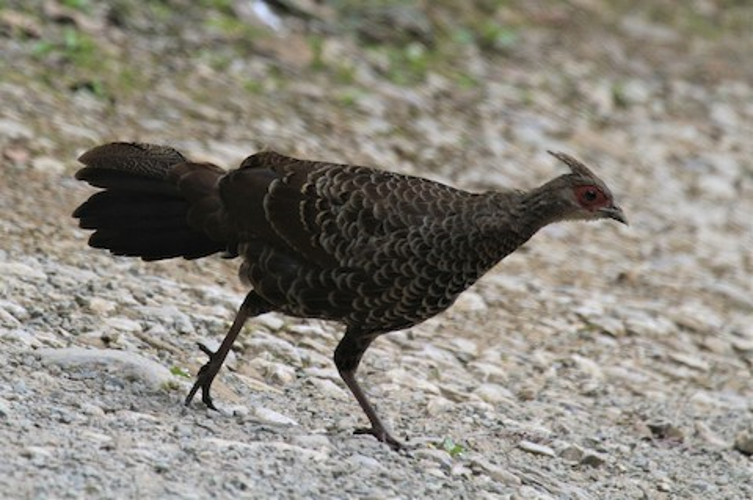
Kalij Pheasant, L. l. melanota or leucomelanos, female with mostly blackish-brown coloration. (Godavari Botanical Gardens, Madhyamanchal, Nepal; September 28, 2017.) © Elena Kreuzberg
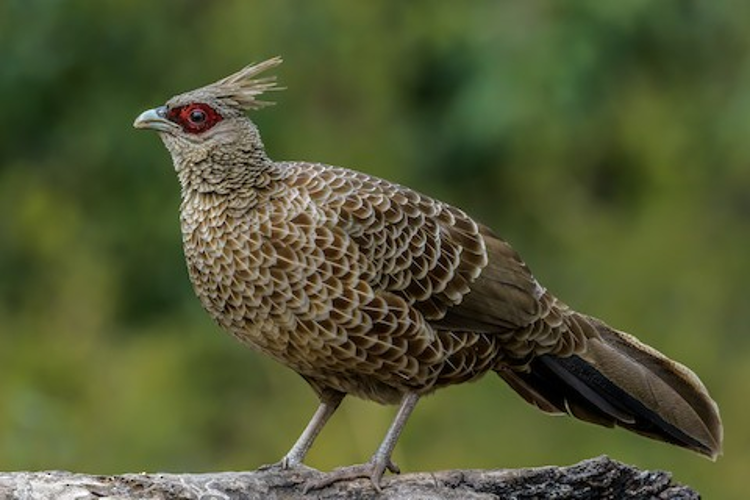
Kalij Pheasant, L. l. hamiltonii or leucomelanos, female with “typical” medium-brown coloration. (Sattal, Nainital, Uttarakhand, India; March 1, 2019.) © Nitin Chandra
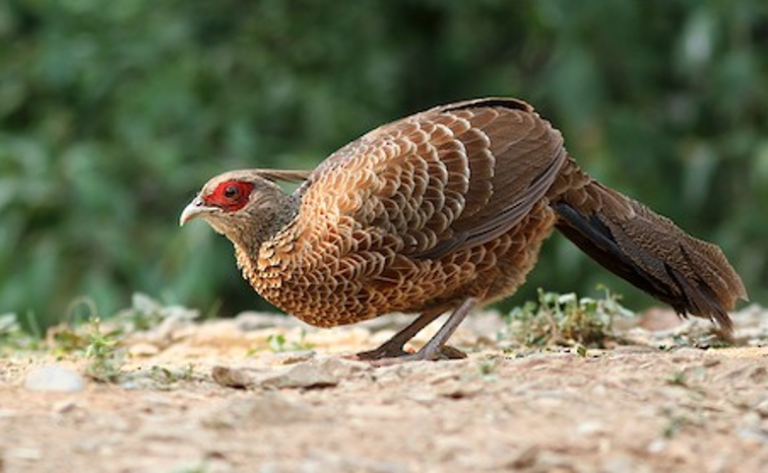
Kalij Pheasant, L. l. hamiltonii or leucomelanos, female with mostly warm rusty-brown coloration. (Sattal, Nainital, Uttarakhand, India; May 3, 2019.) © Pankaj Gupta
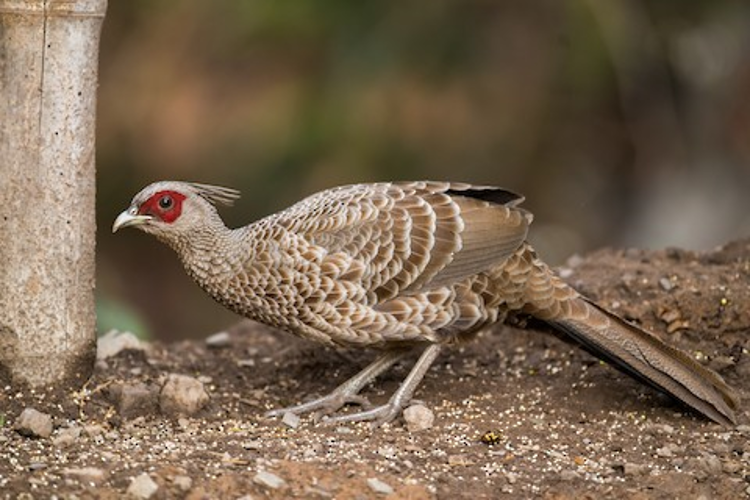
Kalij Pheasant, L. l. hamiltonii or leucomelanos, female with mostly pale-brown coloration. (Sattal, Nainital, Uttarakhand, India; March 31, 2018.) © Cláudia Brasileiro
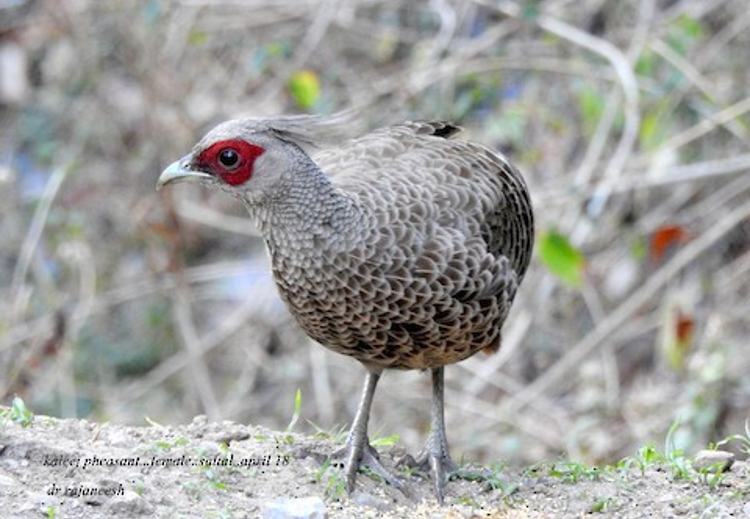
Kalij Pheasant, L. l. hamiltonii or leucomelanos, female with mostly whitish coloration. (Sattal, Nainital, Uttarakhand, India; April 21, 2018.) © Rajaneesh Ghadi
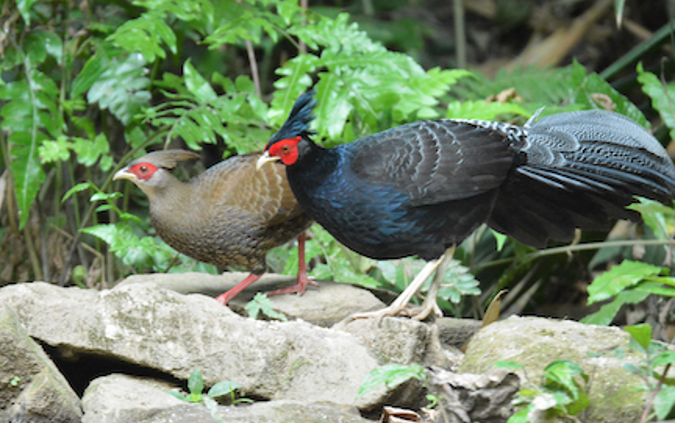
Kalij Pheasant, L. l. lathami, female and black-plumaged male—note that this female is intermediate between those of the typical and Silver races, showing traces of the latter’s general pattern, as well as its pink legs. (Hongbenghe, Yunnan, China; December 25, 2017.) © Larry Chen

Kalij Pheasant, L. l. hamiltonii or leucomelanos, close-up of female showing texture of feathers and bare red facial skin. (Corbett National Park, Uttarakhand, India; April 10, 2017.) © Muhammed Asharaf Kariyil
Females of the “Silver” races have mostly medium-brown upperparts, and a pattern of black-and-white streaks and chevrons on the head, neck, and underparts. Some of the wing and tail feathers are brown, and some are heavily barred with black and white. Their legs are typically, if not always, pink rather than gray.

Kalij Pheasant, L. l. crawfurdii, female showing black-and-white streaks and chevrons on the head, neck, and underparts, and black-and-white barring on the outer tail feathers. (Kaeng Krachan National Park, Phetchaburi, Thailand; March 9, 2019.) © Tim Avery

Kalij Pheasant, L. l. crawfurdii, female showing black-and-white streaks and chevrons on the head, neck, and underparts, and black-white-and-brown barring on most of the tail feathers. (Kaeng Krachan National Park, Phetchaburi, Thailand; February 15, 2017.) © Wich’yanan (Jay) Limparungpatthanakij
Immature males generally resemble females in overall coloration, but do not show any of the females’ characteristic patterns.

Kalij Pheasant, L. l. melanota or leucomelanos, immature male. (Keanakolu Road, Big Island, Hawaii; June 4, 2018.) © Fred Hochstaedter
Voice. Typical contact call is a nervous grunt, repeated like the rusty creak of a wobbling wheel:
Cf. Silver Pheasant. Kalij and Silver Pheasants together comprise 24 recognized subspecies, each of which occupies a patch of southern Asia between northern Pakistan and eastern China, and south through most of Indochina to southwestern Thailand and southern Vietnam. The races of each species vary widely in appearance, and some are confusingly similar or resemble races of the other species. Based on genetic evidence, some subspecies that were traditionally classified as Silver have been reclassified as Kalij.
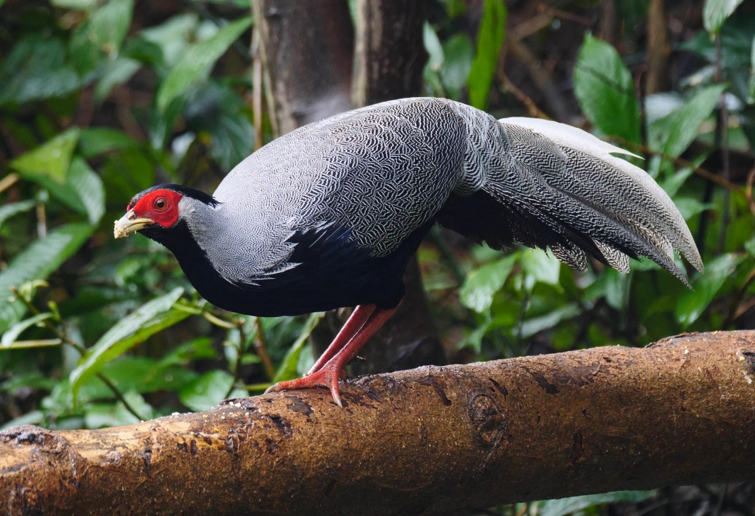
Silver Pheasant. L. n. jonesi, male. (Hornbill Valley, Yingjiang, Yunnan, China; January 9, 2019.) © Josep del Hoyo

Kalij Pheasant. L. 1. crawfordi, male. (Kaeng Krachan National Park, Phetchaburi, Thailand; February 28, 2016.) © Julien Renoult
The zone of occasional or potential overlap between Kalij and Silver Pheasants (as currently understood) runs vertically on a map from western Yunnan Province in southern China south through eastern Myanmar, through northern and central Thailand. The populations west of this area are classified as Kalij and those to the east as Silver. In most areas, location is sufficient for identification—in some cases, location is more reliable than appearance due to the internal variability of each species and their overall similarity to one another.
Confusion is most likely in the mountain forests from Yunnan to Chiang Mai (Thailand), where their normal ranges may be separated by only a few miles, and occasional intermingling occurs, though in most such areas observers will likely have the benefit of local knowledge to understand which race is expected there and which others occur in nearby areas.
Males of the highly similar races have black underparts, white upperparts that are variably covered with fine black vermiculations, medium-to-short tails (by Silver Pheasant standards) that match the upperparts, and a black topknot. As a general rule of thumb, male Silver Pheasants show more contrast: they have whiter upperparts and the black vermiculations stand out as lines, whereas male Kalij Pheasants appear partly gray unless seen at very close range.
Females of both species vary less than males, but overlap more in appearance. Most female Silver Pheasants are plainer brown than their Kalij counterparts, and show far less prominent scaling or barring. However, the most heavily patterned female Silvers are essentially identical to the least heavily patterned Kalij Pheasants, and probably would not distinguishable unless accompanied by a male—but this would not necessarily be a reliable indicator, as they have been known to hybridize.
Notes
Polytypic species consisting of nine recognized subspecies.
The three subspecies that occupy the southeastern portion of its range (in eastern Myanmar and western Thailand) were traditionally classified under the Silver Pheasant, but have been reclassified as Kalij Pheasant based on genetic evidence.
References
BirdLife International. 2016. Lophura leucomelanos. The IUCN Red List of Threatened Species 2016: e.T22679217A92807873. https://dx.doi.org/10.2305/IUCN.UK.2016-3.RLTS.T22679217A92807873.en. (Accessed February 10, 2020.)
eBird. 2020. eBird: An online database of bird distribution and abundance. Cornell Lab of Ornithology, Ithaca, N.Y. http://www.ebird.org. (Accessed February 9, 2020.)
Hawaii Audubon Society. 2005. Hawaii’s Birds (Sixth Edition). Island Heritage Publishing, Waipahu, Hawaii.
McGowan, P.J.K., and G.M. Kirwan. 2020. Kalij Pheasant (Lophura leucomelanos). In Handbook of the Birds of the World Alive (J. del Hoyo, A. Elliott, J. Sargatal, D.A. Christie, and E. de Juana, eds.). Lynx Edicions, Barcelona. https://www.hbw.com/node/53489. (Accessed February 9, 2020.)
Moulin, S., E. Randi, C. Tabarroni, and A. Hennache. 2003. Mitochondrial DNA diversification among the subspecies of the Silver and Kalij Pheasants, Lophura nycthemera and L. leucomelanos, Phasianidae. Ibis 145:E1-E11.
Pratt, H.D., P.L. Bruner, and D.G. Berrett. 1987. A Field Guide to the Birds of Hawaii and the Tropical Pacific. Princeton University Press, Princeton, N.J.

